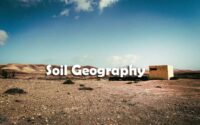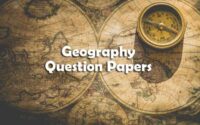SSC CHSL Geography Questions and Answers
SSC CHSL Geography Questions paper pdf for examination is given below. SSC Combined Higher Secondary Level geography question papers direct download links are given in this section. Hence, download the SSC CHSL Geography Previous Paper pdf below.

SSC Combined Higher Secondary Level Geography Previous Papers Pdf help the applicants in their preparation. SSC CHSL Geography previous papers are available here to download. This is the good news for the candidates who are preparing for SSC Combined Higher Secondary Level.
Aspirants can download SSC Combined Higher Secondary Level Model Papers on Geography pdf through online mode. Applicants who are preparing for SSC Combined Higher Secondary Level written exam can download SSC CHSL Geography Sample questions from our website for free.
Questions and Answers on Geography for SSC CHSL
1. Population pyramids visually depict
(A) a population’s age and economic composition
(B) a country’s dependency ratio
(C) the ethnic composition of a population
(D) a country’s population density
2. The term ‘population implosion’ refers to
(A) Rapid declining population
(B) Rapid increasing population
(C) Birth rate is less than death rate
(D) Birth rate and death rate are equal
3. It is estimated that India will take over China to become the most populous country in
(A) 2015
(B) 2025
(C) 2040
(D) 2050
4. According to Malthus, population growth occurs _______, which means that the population increases according to its birth rate.
(A) Proportionally
(B) Exponentially
(C) Arithmetically
(D) positively
5. Which one of the following continents has the highest growth of population?
(A) Africa
(B) Asia
(C) South America
(D) North America
6. The rank-size rule does not work when one considers the distribution of
(A) All of the citizens in a given country
(B) All of the cities in a given country
(C) All of the counties, provinces, or parishes within a given state
(D) All of the polities within a given region
7. The concentric zone model is portrayed as a series of rings, with the outermost ring being the
(A) Central business district
(B) Commuter zone
(C) Working-class zone
(D) Zone of transition
8. In the sector model, also known as the Hoyt model, it is proposed that a city should grow outward from its center because
(A) Private cars will carry commuters in and out of the city effectively
(B) Commercial activities in the city’s center should be relocated to suburbs
(C) Major lines of transportation will carry commuters to outlying areas
(D) Lakes and rivers should cover most of the space in the city’s center
9. Christaller’s central place theory explains that settlements will form in a triangular/hexagonal lattice, with the geometric shapes forming
(A) Thresholds
(B) Hierarchies of cities
(C) Transport routes
(D) Market areas
10. Geographers Chauncy Harris and Edward Ullman developed their multiple-nuclei model during a time when many people began to use cars to navigate cities more easily. Which decade was it?
(A) 1930s
(B) 1910s
(C) 1940s
(D) 1970s
11. Land in the Central Business District (CBD) of a city is more expensive because it
(A) has maximum interaction potential.
(B) is more attractive.
(C) has a better sense of place.
(D) provides a better quality of life.
12. Which model below is based on the assumption that growth happens around several major foci, not just the CBD?
(A) Central place model
(B) Concentric zone model
(C) Sector model
(D) Multiple-nuclei model
13. Which one of the following forms of settlement develops along either side of roads, rivers or canals?
(A) Circular
(B) cross-shaped
(C) linear
(D) square
14. In which of the following regions has the oldest well-documented urban settlement found?
(A) Huang He Valley
(B) Nile Valley
(C) Indus Valley
(D) Mesopotamia
15. _____________ patterns of rural settlements are commonly found in plain areas or wide inter montane valleys.
(A) Circular
(B) Star like
(C) Rectangular
(D) T-shaped village
16. Which one among the following is the first million city in the world?
(A) Paris
(B) London
(C) New York
(D) Beijing
17. Megalopolis is a term coined by
(A) Patrick Geddes
(B) L.C. Stamp
(C) Jean Gottman
(D) Lewis Mumford
18. Which of the following is NOT related to the development of primate city?
(A) small geographical area
(B) small population
(C) simple economy
(D) even topography
19. When the urban periphery grows at the cost of the inner city, it is called
(A) Suburbanisation
(B) Reurbanisation
(C) Gentrification
(D) Counterurbanisation
20. Urban primacy refers to
(A) existence of a single large city in a region
(B) conglomerate of cities in a region
(C) primary activities in urban areas
(D) a hierarchical system of cities
| RRB NTPC | AFCAT |
| TNPSC | SSC CHSL |
| MPSC | SSC CGL |
| UPSC | WBCS |
| CDS | BPSC |
21. Market-gardening activities occur in which zone of von Thunen’s model of agricultural land use?
(A) First zone
(B) Second zone
(C) Third zone
(D) Fourth zone
22. Cash-cropping is a form of
(A) Subsistence agriculture
(B) Extensive agriculture
(C) Mixed farming
(D) Pastoral nomadism
23. All the following crops are products of Mediterranean agriculture EXCEPT
(A) Olives
(B) Grapes
(C) Apples
(D) Dates
24. Which of the following types of agriculture is used most widely throughout the world?
(A) Shifting cultivation
(B) Commercial farming
(C) Plantation
(D) Mediterranean
25. Which of the following is true regarding the growing season?
(A) The Northern Hemisphere has a longer growing season than the Southern Hemisphere.
(B) The Southern Hemisphere has a longer growing season than the Northern Hemisphere.
(C) Polar regions have longer season than equatorial region.
(D) Equatorial regions have longer season than Polar regions.
26. The goal of commercial agriculture is
(A) minimal food security
(B) genetic diversity of seeds
(C) sustainable farming practices
(D) profit maximization
27. Transhumance can best be described as
(A) use of feedlots to raise livestock
(B) seasonal movement of people and livestock over short distances for the purposes of grazing
(C) a practice by which crops are rotated in a four-field system
(D) long cattle drives in the 19th century to move stock from pastures to city
28. Which of the following best characterizes the Green Revolution?
(A) The Green Revolution relied solely on technology to increase crop yields.
(B) The Green Revolution resulted in increased biodiversity worldwide, especially in places where monocropping and high-yield varietals were prevalent.
(C) The Green Revolution was able to increase crop yields and food production in many locations throughout the world, but its impact on the environment, geopolitics, and the world economy has yet to be fully understood.
(D) There have been no major famines since the agricultural practices of the Green Revolution took hold in the 1960s
29. All of the following are true of the Green Revolution EXCEPT
(A) Some countries have instituted bans on genetically modified food.
(B) Crops are grown without the use of synthetic pesticides or fertilizers.
(C) Crops are grown from genetically modified seeds to increase yields.
(D) The high price of seeds and fertilizers perpetuates socioeconomic divide.
30. Whittlesey has taken all the following criteria to classify agricultural regions EXCEPT
(A) The crop and livestock association
(B) The method used to grow the crops and produce the stocks
(C) The intensity of application to the land of labour, capital and organization, and the outturn of the product which results.
(D) The disposal of the products for marketing
31. How many agricultural regions are identified by Whittlesey?
(A) 10
(B) 11
(C) 12
(D) 13
32. Which one of the following describes a system of agriculture where a single crop is grown on a large area?
(A) Shifting Agriculture
(B) Plantation Agriculture
(C) Horticulture
(D) Intensive Agriculture
33. In which one of the following states is terrace cultivation practised?
(A) Punjab
(B) Haryana
(C) Kerala
(D) Uttaranchal
34. The ‘slash and burn’ cultivation is known as Ladang in
(A) Vietnam
(B) Indonesia
(C) Mexico
(D) Brazil
35. Cultivation of wheat requires
(A) Moderate temperature and heavy rains
(B) Moderate temperature and moderate rains
(C) Humid temperature and heavy rains
(D) Humid temperature and moderate rains
36. A buffer state is a politically neutral state that lies between two more powerful states and acts
(A) as a taxing authority for both states
(B) to balance power between the two states
(C) to minimize the religious authority
(D) to enhance both states’ political power
37. A nation-state is most often defined by its twin attributes of sovereignty and
(A) religious tolerance
(B) social democracy
(C) ethnic homogeneity
(D) economic prosperity
38. Gerrymandering is a practice in which a political party attempts to gain an unequal advantage by
(A) nominating a candidate who challenges the state’s constitution
(B) advocating that the electoral college be replaced by the popular vote
(C) changing the boundaries of a legislative district
(D) electing a party chairperson who is a friend of the current president
39. Which of the following political state shapes would likely be the most efficient for transportation and communication?
(A) Compact
(B) Prorupt
(C) Elongated
(D) Fragmented
40. The study of electoral geography is best conducted in
(A) Democratic states
(B) Communist states
(C) Dictatorships
(D) Monarchies
41. Electoral geographers study how people in an area are likely to vote, which can be most conclusively linked to the
(A) physical landscape of the area
(B) election monitors that visit the area
(C) ballots that the people use in the area
(D) ethnicity of populations outside the area
42. McMahon Line is an international boundary between
(A) India and Pakistan
(B) India and Myanmar
(C) India and China
(D) India and Bangladesh
43. In Mackinder’s Heartland theory, the World Island includes
(A) Asia and Europe
(B) Asia and Africa
(C) Europe and Africa
(D) Asia, Europe and Africa
44. Heartland theory failed to take into account
(A) Land power
(B) Naval power
(C) Air power
(D) All of these
45. Rimland theory was proposed by
(A) Rudolf Kjellen
(B) Karl Haushofer
(C) Nicholas Spykman
(D) Adolf Hitler
46. The boundary between the United States and Canada is a
(A) Geometric boundary
(B) Antecedent Boundary
(C) Subsequent Boundary
(D) Superimposed Boundary
47. Which continent has the most landlocked states?
(A) Asia
(B) Africa
(C) North America
(D) Europe
48. A state which places most power in the hands of a central government is a
(A) Federal state
(B) Nation-state
(C) Fragmented state
(D) Unitary state
49. Elongated states may suffer from poor internal communication and difficulty defending its borders. Which of the following is not an elongated state?
(A) Malawi
(B) Gambia
(C) Namibia
(D) Chile
50. A boundary that developed with the evolution of the cultural landscape and is adjusted as the cultural landscape changes is called
(A) Geometric boundary
(B) Antecedent Boundary
(C) Subsequent Boundary


